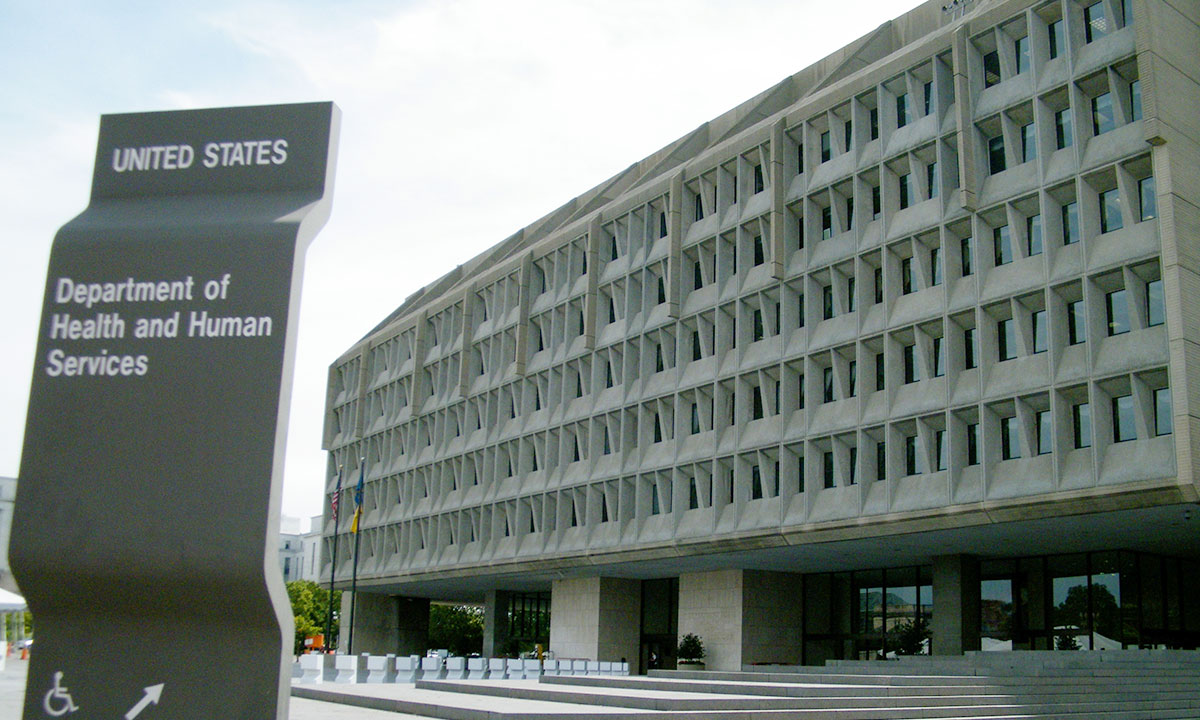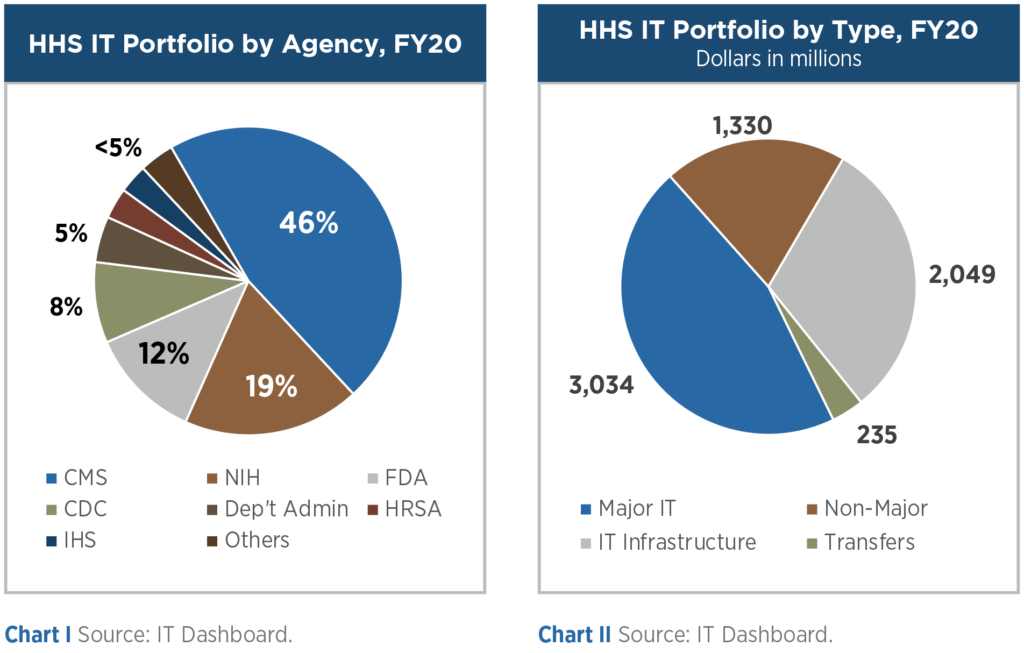

Agencies of the Department of Health and Human Services (HHS) project $6.6 billion in IT portfolio expenditures for FY20 and a cut of $400 million, to $6.2 billion, for FY21, according the IT Dashboard, a data source from the Office of Management and Budget. Agency CIOs provide data for the Dashboard, and for FY21 their projections are based on the President’s FY21 budget. We believe that the $6.2 billion Dashboard estimate represents the low water mark for FY21 HHS IT for three reasons—congressional priorities, pandemic, and campaign promises.
- Congressional priorities: For the past three years, Congress has provided significant increases for HHS over the Trump Administration budget requests. The House-passed FY21 appropriations bill signals that pattern will be repeated.
- Pandemic: The FY21 budget was submitted before the coronavirus pandemic and the influx of hundreds of billions of dollars in emergency appropriations approved by Congress. The Trump Administration reversed its proposed $1.3 billion budget cut to the Centers for Disease Control and Prevention (CDC) due to the pandemic. Dashboard data has not been updated to reflect those changes.
- Campaign promises for infrastructure investments: Both Presidential candidates announced plans to introduce large-scale infrastructure packages post-election. Infrastructure proposals, particularly from a Biden Administration, will include major health-related initiatives that require significant IT components.


A review of the FY20 $6.6 billion HHS portfolio by component agency (see Chart I) shows that the Centers for Medicare and Medicaid Services (CMS) is the largest IT consumer, representing almost half of the total. The National Institutes of Health (NIH) is second at over $1.2 billion, nearly 20% of the total. The Food and Drug Administration (FDA), although a significantly smaller agency, is at 12% with $780 million in planned IT spend, and CDC rounds out the top four at $560 million, or 8%. We expect CDC’s share of the total to increase dramatically when IT Dashboard totals are updated to include pandemic-related supplemental funding. CDC’s IT data modernization initiative alone, for which Congress appropriated $500 million in the CARES Act, would place CDC close to NIH. In addition, CDC was directly provided $3.55 billion in emergency pandemic funding to support surveillance, testing, and tracing functions with significant IT components.
HHS funding, including IT funding, can be found in three separate FY21 appropriations bills: Labor-HHS-Education, which passed the House on July 31st, as well as Agriculture (FDA) and Interior (Indian Health Service (IHS)), which passed the House on July 24th. IT Dashboard reporting includes all HHS agencies, including FDA and IHS, in the HHS IT totals.
One way to use IT Dashboard data to assess the HHS IT Portfolio is to examine the Major IT, Non-major IT, and IT Infrastructure categories. Major IT is defined by OMB in its Capital Planning Guidance as (in part) “an IT Investment… requiring special management attention because of its importance to the mission or function to the government; significant program or policy implications; high executive visibility; high development, operating, or maintenance costs…”. Major projects require detailed business cases and receive enhanced oversight. IT projects not considered Major and not specifically captured as IT Infrastructure are simply classified as Non-major. This is a broad category that includes general IT modernization, data warehousing, management applications, and support of legacy systems. HHS reports nearly 500 Non-major IT programs for FY21, with only one program exceeding $20 million annually.
The IT Infrastructure category includes the Technology Business Management (TBM)-defined categories of Security and Compliance, IT Management, Networks, Data Centers and Cloud, End User, Applications, Delivery and Platforms. CIOs were not required to report data in all of the TBM categories until FY21.
As shown in Chart II, almost half of HHS IT spending (46%) is for Major IT projects. This is unusual when compared to government-wide figures. Major projects represent only about one-quarter of IT spending for the entire federal government. For FY20, the IT Dashboard reported that 26% of the $89 billion in IT spending government-wide was for Major IT. Given the Major IT designations,
HHS IT projects are more likely to be subject to increased oversight, including required business cases and more frequent reporting. For FY21, projects considered Major IT for HHS include a CMS platform for consumers and small businesses to shop for coverage in the health insurance marketplace ($480 million), an FDA Regulatory Submission Receipt and Analysis system to support electronic submissions and business process automation ($47 million), and NIH’s Electronic Research Administration (eRA) electronic processing system for extramural research grants ($39 million). Funding levels listed are for FY21 only; business cases for each Major IT project include full cost profiles.
HHS IT Infrastructure is at $2.0 billion for FY20, just over 30% of the total IT spend for the Department. Within the $2.0 billion, the two functions of Data Centers and Cloud and Security/Compliance account for half of the spending. For FY21 and beyond, we expect more granularity as OMB requires all IT Infrastructure reporting in the TBM-defined subcategories. The smallest HHS IT category, Transfers, is for funds sent to other agencies or departments, such as the Office of Personnel Management, to support joint IT needs managed outside HHS.
The IT Dashboard provides insight into the fundamental HHS IT projects that are likely to endure and expand. We expect pandemic-related emergency funding to increase IT spend across all HHS agencies, with a portion of those funds going to state and local IT needs. The FY21 appropriations process will also address IT needs in public health, providing another boost. FY21 appropriations bills are being negotiated in the lame duck session before the current continuing resolution ends on December 11th. Or, if that effort fails, as the bills are finalized in the 117th Congress in February or March.
The coronavirus pandemic exposed significant faults in public health infrastructure. Over the next five years, we expect bipartisan backing for major investments in technologies supporting federal, state and local public health, from replacement of legacy systems to use of predictive analytics and development of integrated health networks.